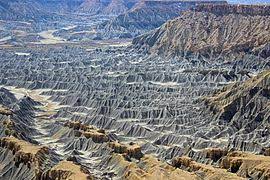Badland topography is a type of landscape characterized by deep gullies, rugged terrain, and steep slopes. It is typically found in arid and semi-arid regions, where the land is eroded by wind and water over thousands of years. In this article, we will explore the characteristics and formation of badland topography and its significance to the environment.

Badland topography is formed by the erosion of soft sedimentary rocks, such as clay, sandstone, and shale, by wind and water. The erosion occurs at a much faster rate than the natural process of soil formation, resulting in the formation of steep-sided gullies, ridges, and mazes. The unique shape of badlands is often caused by the different rates of erosion of various layers of sedimentary rocks, creating a layered effect.
Badlands are often found in dry regions with little vegetation cover, such as deserts and grasslands. The lack of vegetation cover exposes the soil to erosion by wind and water, leading to the formation of deep gullies and canyons. The formation of badlands can take thousands of years, and the resulting landscape can be both beautiful and treacherous.
Badland topography has significant ecological and geological significance. The rugged terrain and steep slopes provide habitats for many unique plant and animal species adapted to the arid environment. The porous sedimentary rocks also allow for the storage of groundwater, which is crucial for maintaining the water balance in dry regions. Badlands are also significant geological sites, providing a glimpse into the history of the earth’s geological formation and evolution.
However, the formation of badland topography can also have negative impacts on the environment. The erosion of soil and sediment can lead to soil degradation and loss of agricultural land. It can also lead to water pollution and affect the quality of water resources, affecting the livelihoods of people who depend on them.
To mitigate the negative impacts of badland topography, various conservation and restoration measures have been initiated. These measures include afforestation, soil conservation, and the use of sustainable land-use practices. The conservation and restoration of badlands not only protect the environment but also provide economic and social benefits to the local communities.
In conclusion, badland topography is a unique and significant landscape found in arid and semi-arid regions. While it has significant ecological and geological significance, it can also have negative impacts on the environment. The conservation and restoration of badlands are essential for maintaining the ecological balance and ensuring sustainable development in these regions.
Important Links